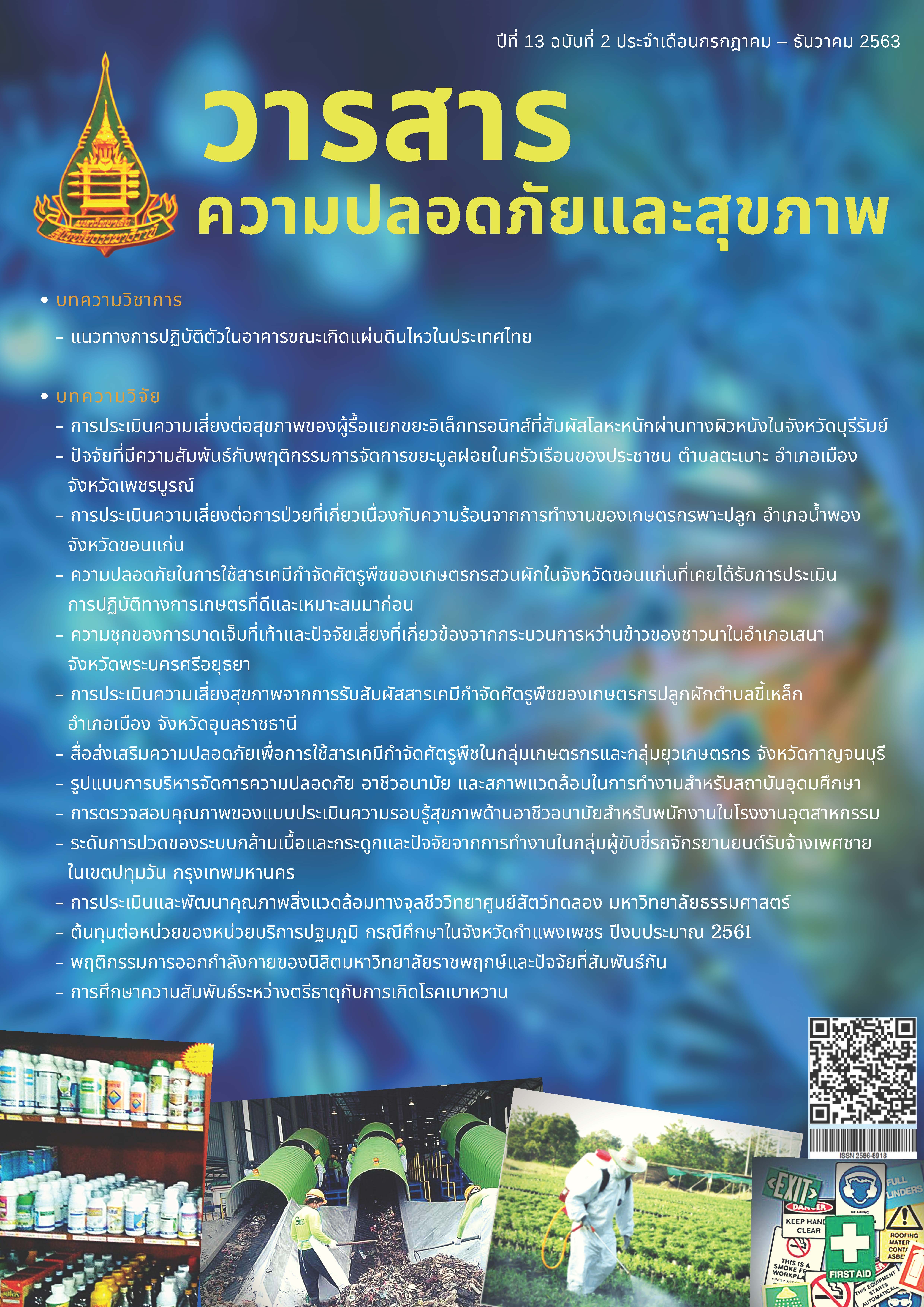Health Risk Assessment of Electronic Waste Dismantling Workers Exposed to Heavy Metals via Dermal Absorption in Burirum Province
Main Article Content
Abstract
This applied science research aimed to estimate the health risk of electronic waste dismantling workers at Dang Yai, Baan Mai Chai Poj District, Buriram Province, exposed to heavy metals through dermal absorption. The samples of dust adhered to both their hands were collected by wiping technique using wiped gauze soaked with isopropanol 20% v/v before starting dismantling in the morning, after morning work, after evening work, and after finishing their work in the evening.
The results showed that the average concentrations of arsenic, lead, copper, cadmium, nickel, and zinc in the dust collected from workers’ hands were in the range of 0.02 – 8.44, 81.50 – 6,038.26, 785.43 – 49,899.31, 2.00 – 63.25, 81.50 – 188.36 and 2,592.91– 40,722.91 mg/kg, respectively. The maximum in non-cancer risk, hazard quotients (HQ), was found in arsenic absorption with the 95% CI of 0.263 – 0.530, while the HQ of lead showed the minimum, 1.00 × 10-9 - 2.70 × 10-9. All HQs less than 1 implied that there was no increase in health risk for the workers exposed to these heavy metals through their hands. However, the workers would be recommended to wash their hands properly by using cleaning agents in order to remove residual heavy metals after finish dismantling effectively.
Article Details
Journal of Safety and Health is licensed under a Creative Commons Attribution-NonCommercial-NoDerivatives 4.0 International (CC BY-NC-ND 4.0) licence, unless otherwise stated.
References
กระทรวงสาธารณสุข, กรมอนามัย และกรมควบคุมโรค. (2557). แนวทางการเฝ้าระวังพื้นที่เสี่ยง กรณีขยะอิเล็กทรอนิกส์. กรุงเทพฯ: โรงพิมพ์ชุมนุมสหกรณ์การเกษตรแห่งประเทศไทย.
สถาบันวิจัยเพื่อการพัฒนาประเทศไทย. (2560). การจัดการขยะอิเล็กทรอนิกส์ในประเทศไทย. กรุงเทพฯ.
สุจิตรา วาสนาดำรงดี. (2558). สถานการณ์ปัญหาขยะอิเล็กทรอนิกส์. ใน เอกสารประกอบการเสวนาวิชาการ เรื่อง “ขยะอิเล็กทรอนิกส์: จัดการอย่างไรให้ปลอดภัย”. วันที่ 12 มิถุนายน 2558, กรุงเทพ: สถาบันวิจัยสภาวะแวดล้อม จุฬาลงกรณ์มหาวิทยาลัย.
Bi, X., Simoneit, B. R., Wang, Z., Wang, X., Sheng, G., & Fu, J. (2010). The major components of particles emitted during recycling of waste printed circuit boards in a typical e-waste workshop of South China. Atmospheric Environment, 44(35), 4440-4445.
Deng, W. J., Louie, P. K. K., Liu, W. K., Bi, X. H., Fu, J. M., & Wong, M. H. (2006). Atmospheric levels and cytotoxicity of PAHs and heavy metals in TSP and PM2. 5 at an electronic waste recycling site in southeast China. Atmospheric Environment, 40(36), 6945-6955.
Health Risk Assessment Guidance for Metals (HERAG). (2007). Assessment of Occupational Dermal Exposure and Dermal absorption for Metals and Inorganic Compound.Occupational dermal exposure and dermal absorption, HERAG.
Kaewrueng, P., Siriwong, W., & Siripanich, S. (2013). Risk assessment of heavy metal associated with dermal exposure in incense workers in small household factories at Roi-et province,Thailand. Journal of Health Research, 27(4), 217-223.
Lai, H. Y., Hseu, Z. Y., Chen, T. C., Chen, B. C., Guo, H. Y., & Chen, Z. S. (2010). Health risk-based assessment and management of heavy metals-contaminated soil sites in Taiwan. International journal of environmental research and public health, 7(10), 3595-3614.
Robinson, B. H. (2009). E-waste: an assessment of global production and environmental impacts. Science of the total environment, 408(2), 183-191.
Singh, M., Thind, P.S., & John, S. (2018). Health risk assessment of the workers exposed to the heavy metals in e-waste recycling sites of Chandigarh and Ludhiana,Punjab, India. Chemosphere, 203, 426-433.
United States Environmental Protection Agency (U.S. EPA). (1987). Arsenic, inorganic. Retrieved from: https://cfpub.epa.gov/ncea/iris/iris_documents/documents/subst/0278_summary.pdf
United States Environmental Protection Agency (U.S. EPA). (2009). Risk Assessment Guidance for Superfund Volume I: Human Health Evaluation Manual (Part F) Final. EPA-540-R-070-002. Office of Superfund Remediation and Technology Innovation, Environmental Protection Agency. Washington, D.C., U.S.EPA.
United States Environmental Protection Agency (U.S. EPA). (2004). Risk Assessment Guideline for Superfund Vol.1 Human Health Evaluation Manual (part E) Supplemental Guidance from Dermal Risk Assessment. Washington, D.C., U.S.EPA.
Wcisło, E., Ioven, D., Kucharski, R., & Szdzuj, J. (2002). Human health risk assessment case study: an abandoned metal smelter site in Poland. Chemosphere, 47(5), 507-515.

